2017 Alfa Romeo Giulia height
[x] Cancel search: heightPage 29 of 268
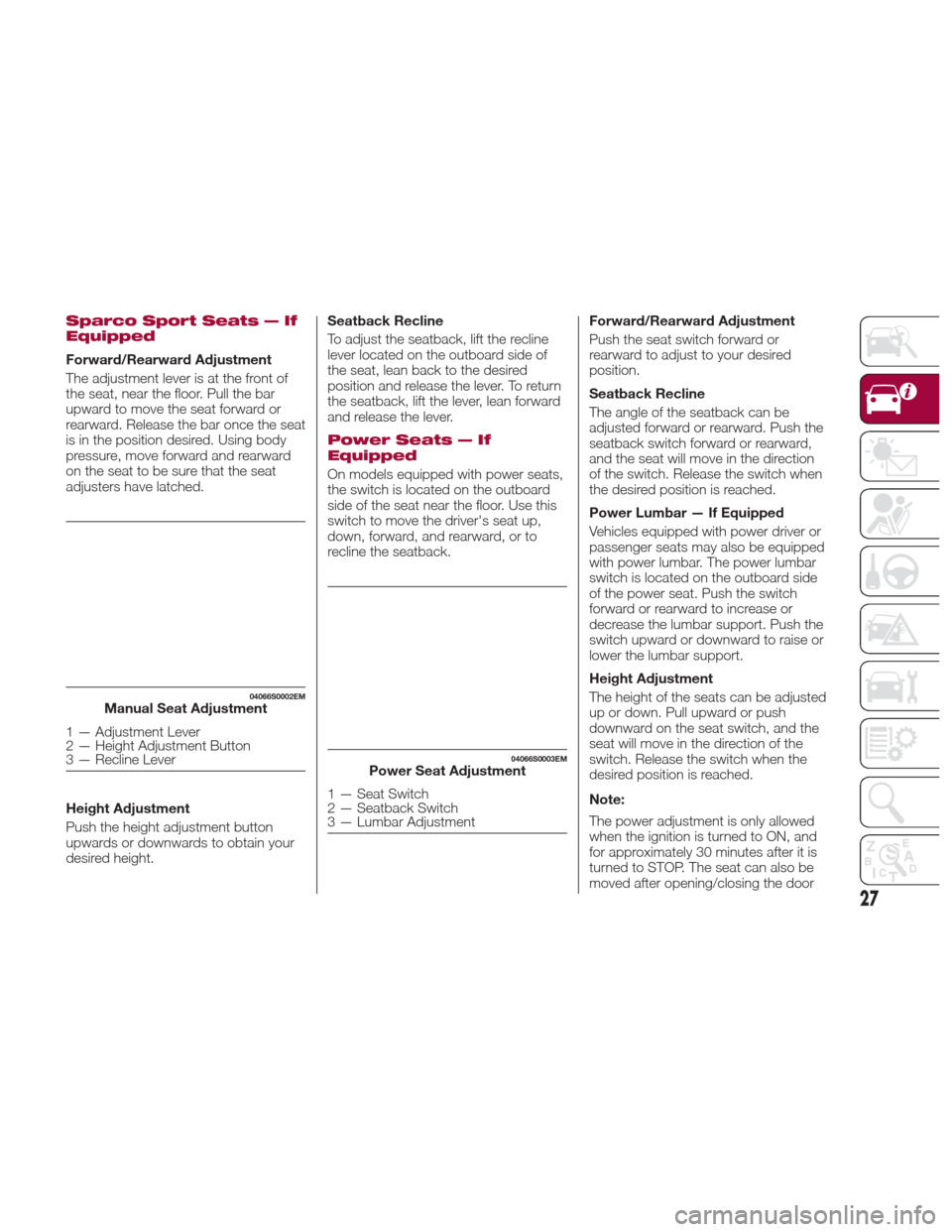
Sparco Sport Seats — If
Equipped
Forward/Rearward Adjustment
The adjustment lever is at the front of
the seat, near the floor. Pull the bar
upward to move the seat forward or
rearward. Release the bar once the seat
is in the position desired. Using body
pressure, move forward and rearward
on the seat to be sure that the seat
adjusters have latched.
Height Adjustment
Push the height adjustment button
upwards or downwards to obtain your
desired height.Seatback Recline
To adjust the seatback, lift the recline
lever located on the outboard side of
the seat, lean back to the desired
position and release the lever. To return
the seatback, lift the lever, lean forward
and release the lever.
Power Seats — If
Equipped
On models equipped with power seats,
the switch is located on the outboard
side of the seat near the floor. Use this
switch to move the driver's seat up,
down, forward, and rearward, or to
recline the seatback.
Forward/Rearward Adjustment
Push the seat switch forward or
rearward to adjust to your desired
position.
Seatback Recline
The angle of the seatback can be
adjusted forward or rearward. Push the
seatback switch forward or rearward,
and the seat will move in the direction
of the switch. Release the switch when
the desired position is reached.
Power Lumbar — If Equipped
Vehicles equipped with power driver or
passenger seats may also be equipped
with power lumbar. The power lumbar
switch is located on the outboard side
of the power seat. Push the switch
forward or rearward to increase or
decrease the lumbar support. Push the
switch upward or downward to raise or
lower the lumbar support.
Height Adjustment
The height of the seats can be adjusted
up or down. Pull upward or push
downward on the seat switch, and the
seat will move in the direction of the
switch. Release the switch when the
desired position is reached.
Note:
The power adjustment is only allowed
when the ignition is turned to ON, and
for approximately 30 minutes after it is
turned to STOP. The seat can also be
moved after opening/closing the door
04066S0002EMManual Seat Adjustment
1 — Adjustment Lever
2 — Height Adjustment Button
3 — Recline Lever
04066S0003EMPower Seat Adjustment
1 — Seat Switch
2 — Seatback Switch
3 — Lumbar Adjustment
27
Page 32 of 268

Sport Seat Head
Restraints
Your vehicle may be equipped with
non-adjustable head restraints on the
driver's and passenger's seatbacks.
The non-adjustable head restraints
consist of a trimmed foam covering
over the upper structure of the
seatbacks and are intended to help
protect you and the passenger from
neck injury.
Adjust the seatbacks to their upright,
on-road positions so that the head
restraint is positioned as close as
possible to the back of your head.
Warning!
Be certain that the seatback is locked
securely into position. Otherwise, the seat
will not provide the proper stability for
passengers. An improperly latched
seatback could cause serious injury.
Front Head Restraints
(Adjustments) — If
Equipped
The front head restraints may be
height-adjustable. To adjust them,
operate as follows:
Upward adjustment: raise the head
restraint until it clicks into place.
Downward adjustment: push button
and lower the head restraint.
Warning!
All occupants, including the driver,
should not operate a vehicle or sit in a
vehicle’s seat until the head restraints are
placed in their proper positions in order to
minimize the risk of neck injury in the event
of a crash.
Head restraints should never be
adjusted while the vehicle is in motion.
Driving a vehicle with the head restraints
improperly adjusted or removed could
cause serious injury or death in the event of
a collision.
Note:
To allow maximum visibility for the
driver, if the head restraints are not
used, lower the head restraints to the
fully down position.
Rear Head Restraints
(Adjustments)
The height of the outboard head
restraints can be adjusted. The head
restraint of the center seat, if equipped,
cannot be adjusted, only removed.
For upward adjustment, pull up on the
head restraint until it clicks into place.
For downward adjustment, push in
button 1 and lower the head restraint
while holding the button to the desired
height.
Note: To allow maximum visibility for
the driver, if the head restraints are not
in use, lower the head restraints to the
fully down position.
04076S0002EMRear Head Restraint
1—Button1
2—Button2
30
GETTING TO KNOW YOUR VEHICLE
Page 33 of 268
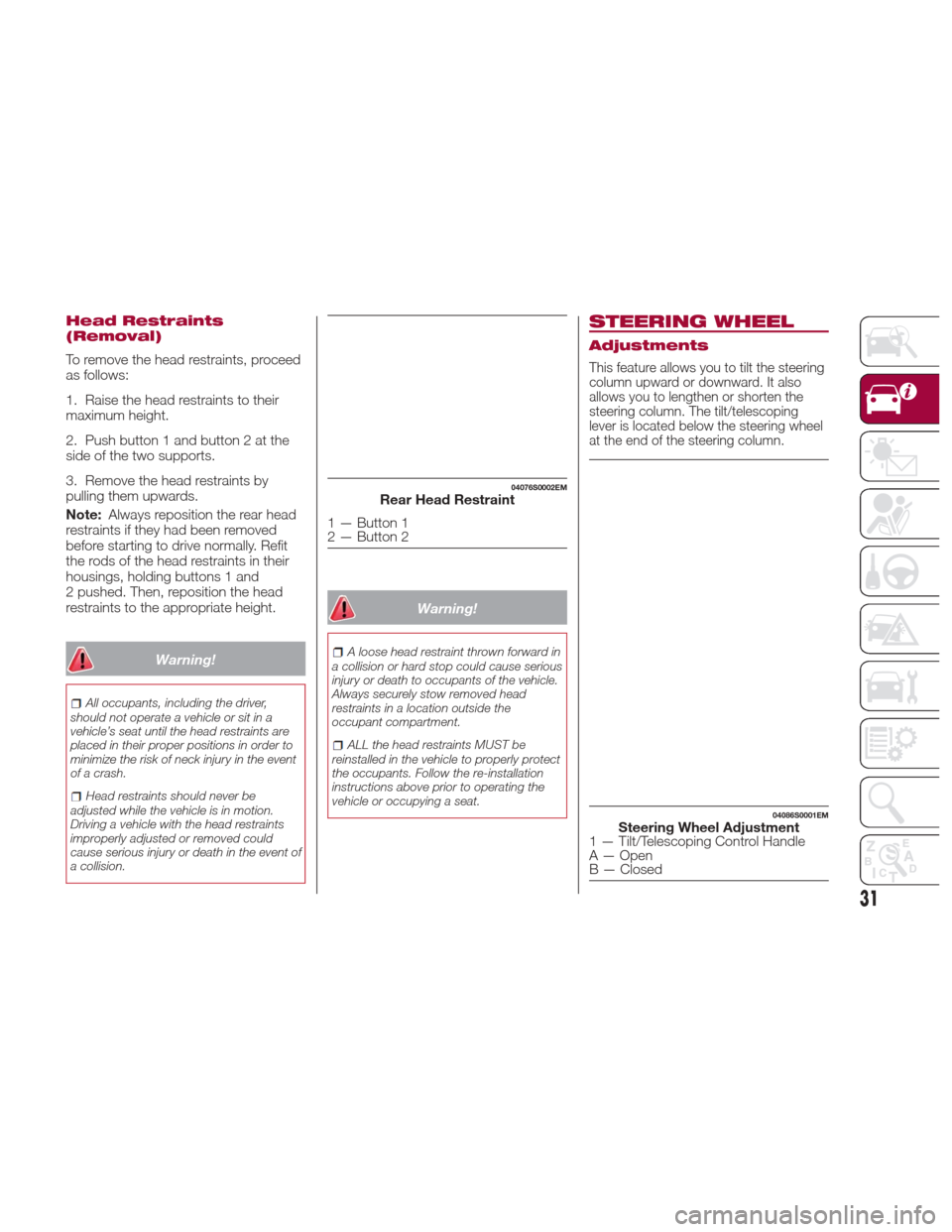
Head Restraints
(Removal)
To remove the head restraints, proceed
as follows:
1. Raise the head restraints to their
maximum height.
2. Push button 1 and button 2 at the
side of the two supports.
3. Remove the head restraints by
pulling them upwards.
Note:Always reposition the rear head
restraints if they had been removed
before starting to drive normally. Refit
the rods of the head restraints in their
housings, holding buttons 1 and
2 pushed. Then, reposition the head
restraints to the appropriate height.
Warning!
All occupants, including the driver,
should not operate a vehicle or sit in a
vehicle’s seat until the head restraints are
placed in their proper positions in order to
minimize the risk of neck injury in the event
of a crash.
Head restraints should never be
adjusted while the vehicle is in motion.
Driving a vehicle with the head restraints
improperly adjusted or removed could
cause serious injury or death in the event of
a collision.
Warning!
A loose head restraint thrown forward in
a collision or hard stop could cause serious
injury or death to occupants of the vehicle.
Always securely stow removed head
restraints in a location outside the
occupant compartment.
ALL the head restraints MUST be
reinstalled in the vehicle to properly protect
the occupants. Follow the re-installation
instructions above prior to operating the
vehicle or occupying a seat.
STEERING WHEEL
Adjustments
This feature allows you to tilt the steering
column upward or downward. It also
allows you to lengthen or shorten the
steering column. The tilt/telescoping
lever is located below the steering wheel
at the end of the steering column.
04076S0002EMRear Head Restraint
1—Button1
2—Button2
04086S0001EMSteering Wheel Adjustment1 — Tilt/Telescoping Control Handle
A — Open
B — Closed
31
Page 126 of 268
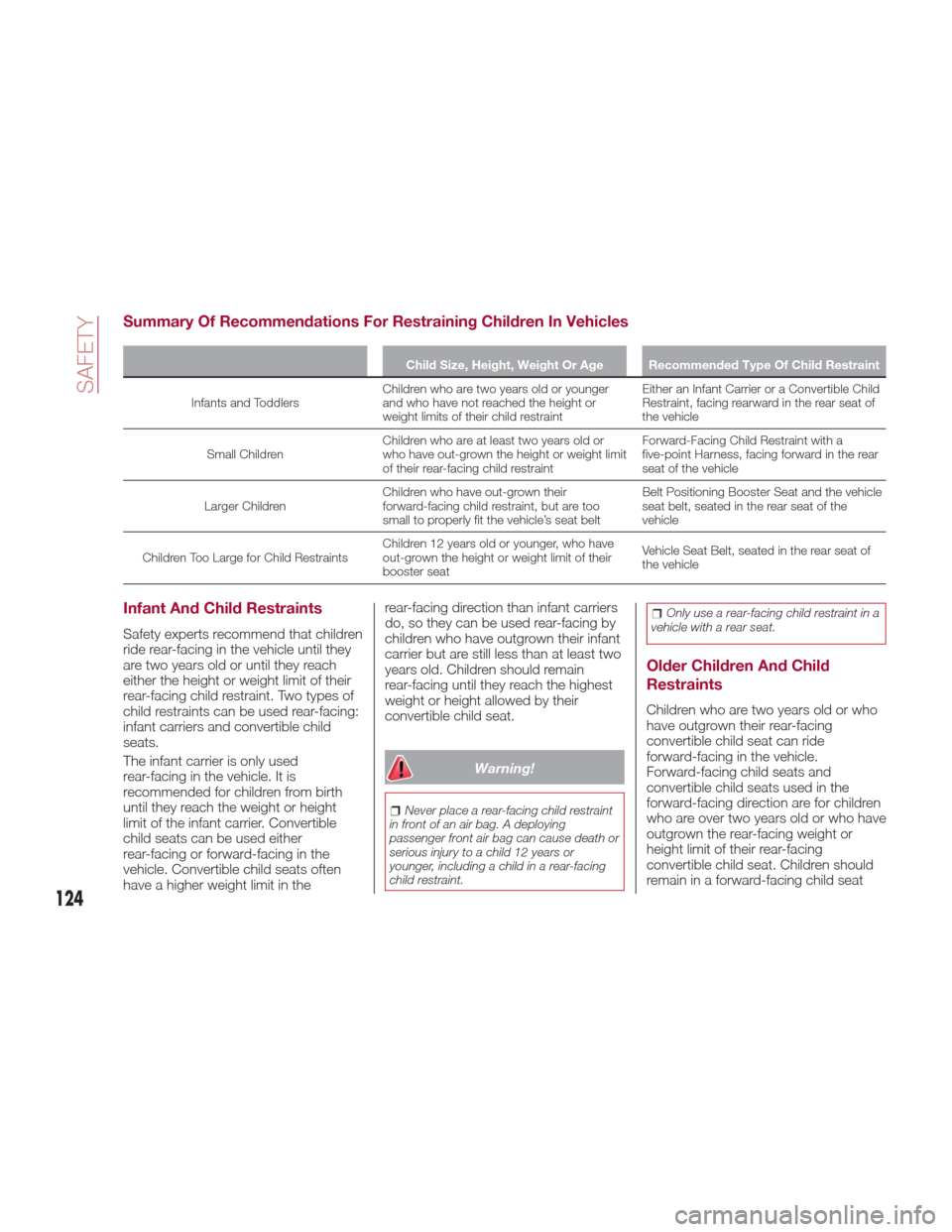
Summary Of Recommendations For Restraining Children In Vehicles
Child Size, Height, Weight Or Age Recommended Type Of Child Restraint
Infants and Toddlers Childr
en who are two years old or younger
and who have not reached the height or
weight limits of their child restraint Either an Infant Carrier or a Convertible Child
Restraint, facing rearward in the rear seat of
the vehicle
Small Children Children who are at least two years old or
who have out-grown the height or weight limit
of their rear-facing child restraint Forward-Facing Child Restraint with a
five-point Harness, facing forward in the rear
seat of the vehicle
Larger Children Children who have out-grown their
forward-facing child restraint, but are too
small to properly fit the vehicle’s seat belt Belt Positioning Booster Seat and the vehicle
seat belt, seated in the rear seat of the
vehicle
Children Too Large for Child Restraints Children 12 years old or younger, who have
out-grown the height or weight limit of their
booster seat Vehicle Seat Belt, seated in the rear seat of
the vehicle
Infant And Child Restraints
Safety experts recommend that children
ride rear-facing in the vehicle until they
are two years old or until they reach
either the height or weight limit of their
rear-facing child restraint. Two types of
child restraints can be used rear-facing:
infant carriers and convertible child
seats.
The infant carrier is only used
rear-facing in the vehicle. It is
recommended for children from birth
until they reach the weight or height
limit of the infant carrier. Convertible
child seats can be used either
rear-facing or forward-facing in the
vehicle. Convertible child seats often
have a higher weight limit in therear-facing direction than infant carriers
do, so they can be used rear-facing by
children who have outgrown their infant
carrier but are still less than at least two
years old. Children should remain
rear-facing until they reach the highest
weight or height allowed by their
convertible child seat.
Warning!
Never place a rear-facing child restraint
in front of an air bag. A deploying
passenger front air bag can cause death or
serious injury to a child 12 years or
younger, including a child in a rear-facing
child restraint.
Only use a rear-facing child restraint in a
vehicle with a rear seat.
Older Children And Child
Restraints
Children who are two years old or who
have outgrown their rear-facing
convertible child seat can ride
forward-facing in the vehicle.
Forward-facing child seats and
convertible child seats used in the
forward-facing direction are for children
who are over two years old or who have
outgrown the rear-facing weight or
height limit of their rear-facing
convertible child seat. Children should
remain in a forward-facing child seat
124
SAFETY
Page 127 of 268
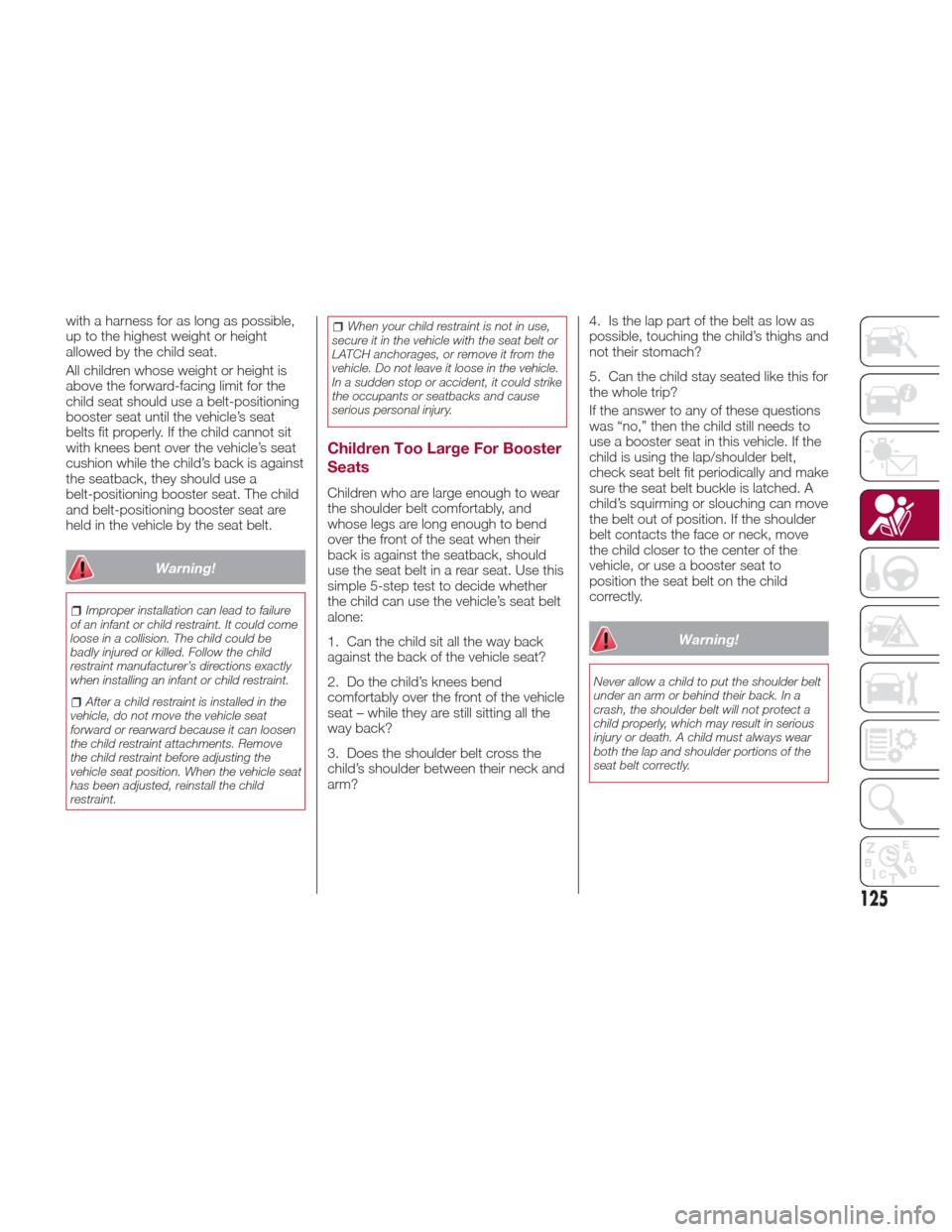
with a harness for as long as possible,
up to the highest weight or height
allowed by the child seat.
All children whose weight or height is
above the forward-facing limit for the
child seat should use a belt-positioning
booster seat until the vehicle’s seat
belts fit properly. If the child cannot sit
with knees bent over the vehicle’s seat
cushion while the child’s back is against
the seatback, they should use a
belt-positioning booster seat. The child
and belt-positioning booster seat are
held in the vehicle by the seat belt.
Warning!
Improper installation can lead to failure
of an infant or child restraint. It could come
loose in a collision. The child could be
badly injured or killed. Follow the child
restraint manufacturer’s directions exactly
when installing an infant or child restraint.
After a child restraint is installed in the
vehicle, do not move the vehicle seat
forward or rearward because it can loosen
the child restraint attachments. Remove
the child restraint before adjusting the
vehicle seat position. When the vehicle seat
has been adjusted, reinstall the child
restraint.
When your child restraint is not in use,
secure it in the vehicle with the seat belt or
LATCH anchorages, or remove it from the
vehicle. Do not leave it loose in the vehicle.
In a sudden stop or accident, it could strike
the occupants or seatbacks and cause
serious personal injury.
Children Too Large For Booster
Seats
Children who are large enough to wear
the shoulder belt comfortably, and
whose legs are long enough to bend
over the front of the seat when their
back is against the seatback, should
use the seat belt in a rear seat. Use this
simple 5-step test to decide whether
the child can use the vehicle’s seat belt
alone:
1. Can the child sit all the way back
against the back of the vehicle seat?
2. Do the child’s knees bend
comfortably over the front of the vehicle
seat – while they are still sitting all the
way back?
3. Does the shoulder belt cross the
child’s shoulder between their neck and
arm? 4. Is the lap part of the belt as low as
possible, touching the child’s thighs and
not their stomach?
5. Can the child stay seated like this for
the whole trip?
If the answer to any of these questions
was “no,” then the child still needs to
use a booster seat in this vehicle. If the
child is using the lap/shoulder belt,
check seat belt fit periodically and make
sure the seat belt buckle is latched. A
child’s squirming or slouching can move
the belt out of position. If the shoulder
belt contacts the face or neck, move
the child closer to the center of the
vehicle, or use a booster seat to
position the seat belt on the child
correctly.
Warning!
Never allow a child to put the shoulder belt
under an arm or behind their back. In a
crash, the shoulder belt will not protect a
child properly, which may result in serious
injury or death. A child must always wear
both the lap and shoulder portions of the
seat belt correctly.
125
Page 202 of 268
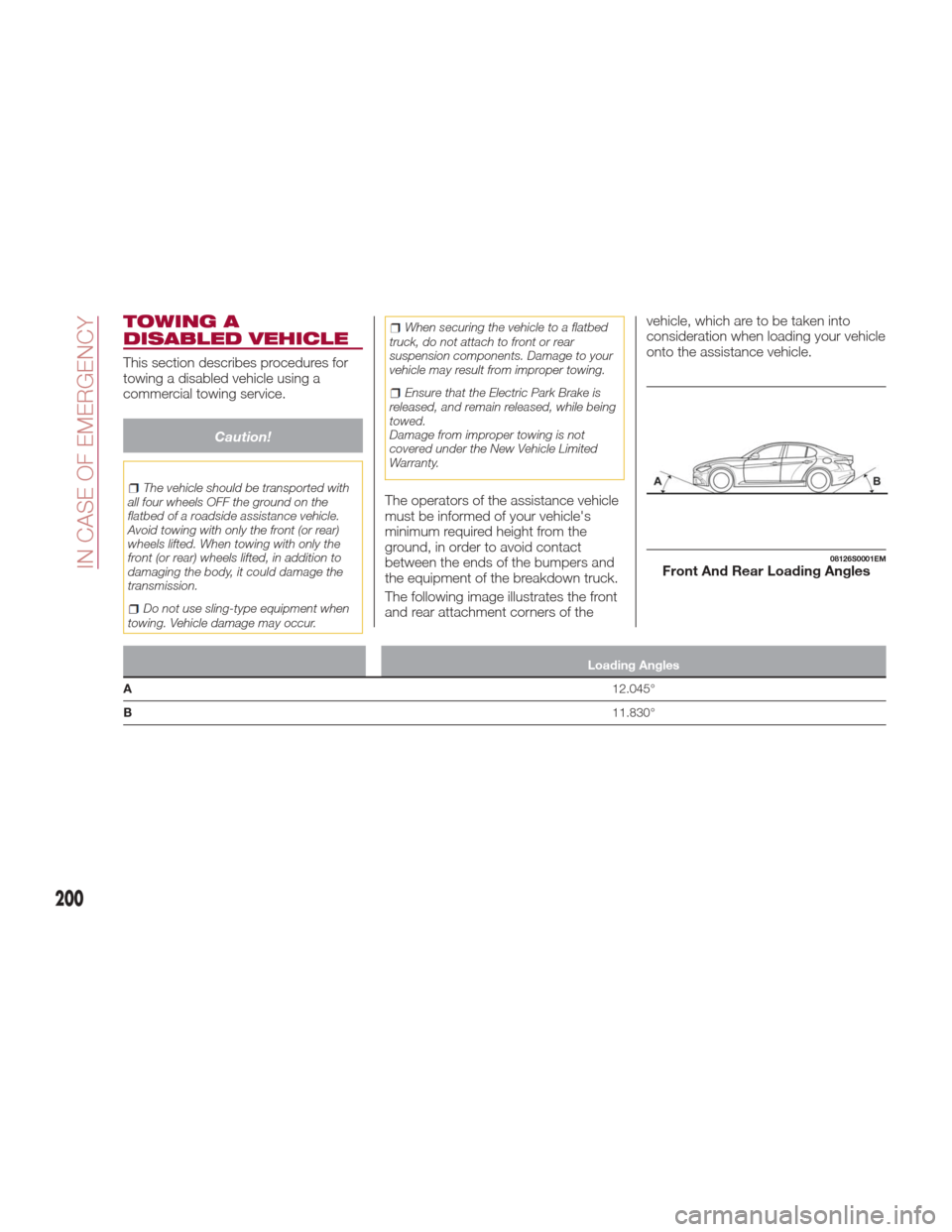
TOWING A
DISABLED VEHICLE
This section describes procedures for
towing a disabled vehicle using a
commercial towing service.
Caution!
The vehicle should be transported with
all four wheels OFF the ground on the
flatbed of a roadside assistance vehicle.
Avoid towing with only the front (or rear)
wheels lifted. When towing with only the
front (or rear) wheels lifted, in addition to
damaging the body, it could damage the
transmission.
Do not use sling-type equipment when
towing. Vehicle damage may occur.
When securing the vehicle to a flatbed
truck, do not attach to front or rear
suspension components. Damage to your
vehicle may result from improper towing.
Ensure that the Electric Park Brake is
released, and remain released, while being
towed.
Damage from improper towing is not
covered under the New Vehicle Limited
Warranty.
The operators of the assistance vehicle
must be informed of your vehicle's
minimum required height from the
ground, in order to avoid contact
between the ends of the bumpers and
the equipment of the breakdown truck.
The following image illustrates the front
and rear attachment corners of the vehicle, which are to be taken into
consideration when loading your vehicle
onto the assistance vehicle.
Loading Angles
A 12.045°
B 11.830°
08126S0001EMFront And Rear Loading Angles
200
IN CASE OF EMERGENCY
Page 248 of 268
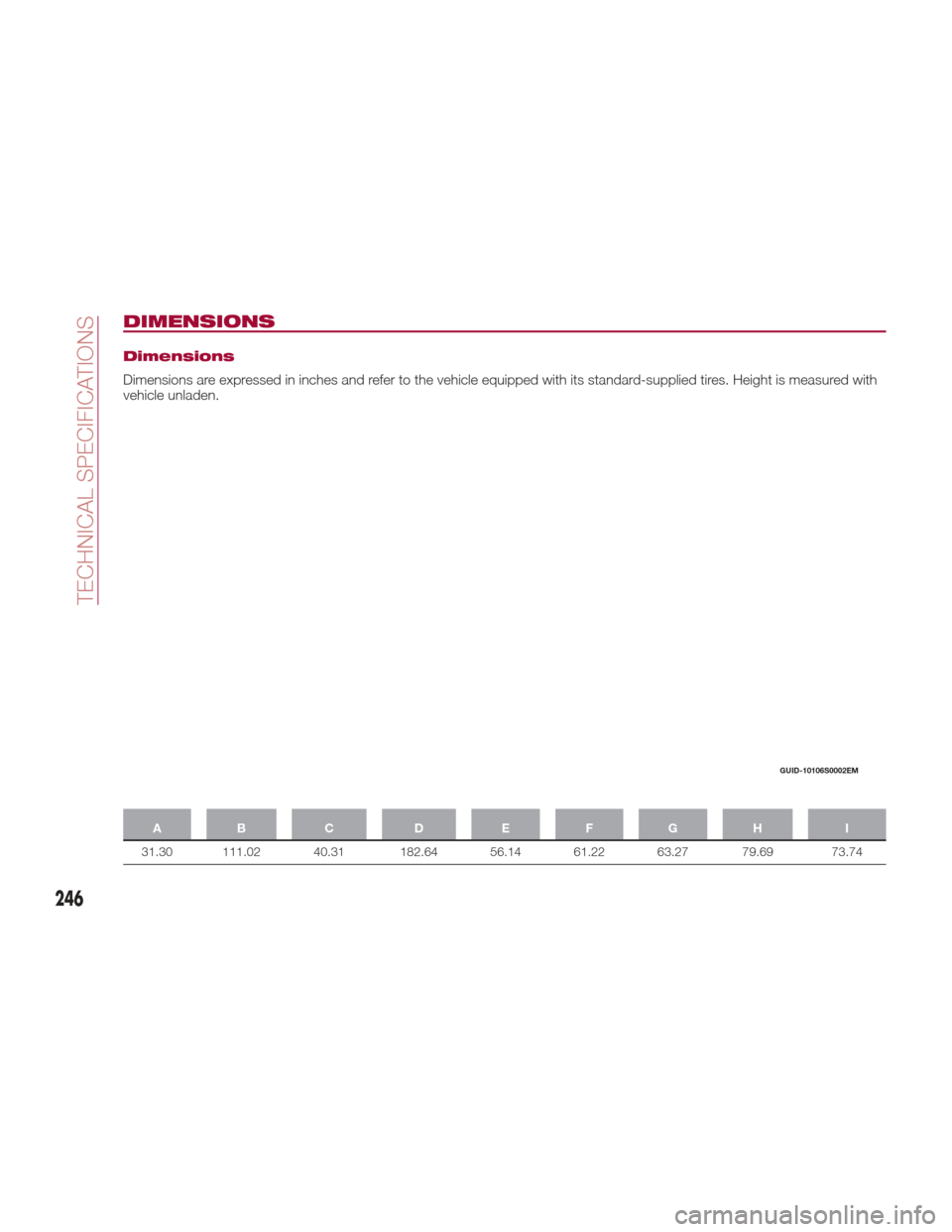
DIMENSIONS
Dimensions
Dimensions are expressed in inches and refer to the vehicle equipped with its standard-supplied tires. Height is measured with
vehicle unladen.
AB C D EFGH I
31.30 111.02 40.31 182.64 56.14 61.22 63.27 79.69 73.74
GUID-10106S0002EM
246
TECHNICAL SPECIFICATIONS
Page 265 of 268

PretensionersSeat Belts ..............113
Prolonged vehicle inactivity ......234
Radial Ply Tires.............231
Radio Frequency General Information ......16,18,25
Radio transmitters and mobile phones ...................4
Rear Camera ...............170
Rear Cross Path ..............99
Rear Seats .................29
Rear View Mirrors .............33
Reformulated Gasoline .........249
Refueling procedure ...........172
Refueling the vehicle ..........172
Refuelling ................ .251
Reminder, Seat Belt ...........109
Remote Starting System ........135
Replacement Tires ............232
Replacing a bulb .............180
Replacing an external bulb ......183
Replacing an internal bulb .......184
Reporting Safety Defects .......258
Restraint, Head ..............29
Restraints, Child .............123
Rimsandtires ............. .221
Safety Defects, Reporting.......258
Safety Information, Tire .........221
Saving fuel ................ .175SBL Function
................36
Scheduled servicing ...........205
Scheduled servicing program (2.9 V6 gasoline engine
versions) ............... .206
Seat Belt Energy Management Feature . . .113
Lap/Shoulder Belt Untwisting . . .112
Lap/Shoulder Belts .........110
Pregnant Women ..........113
Seat Belt Pretensioner .......113
Seat Belt Reminder .........109
Seat Belt Reminder ...........109
Seat Belts ................ .109
Child Restraint ............123
Front Seat ...........109,110
Pregnant Women ..........113
Pretensioners ............113
Rear Seat ...............110
Untwisting Procedure .......112
Seats .....................26
Adjustment .............26,27
Head Restraints ............29
Height Adjustment ..........27
Power ..................27
Tilting ..................27
Service Assistance ...........256
Service Contract .............257
Service Manuals .............259 Servicing procedures
..........214
Shoulder Belts ..............110
Signals, Turn ................36
Snow chains ...............229
Snow Tires ............... .228
Spare Tire ..............226,227
Speed Control Accel/Decel .............155
Cancel ................ .155
Resume ............... .155
S
et .................. .154
Speed Control (Cruise Control) .........154,156
Speed Limiter ...............152
Starting .................. .198
Starting And Operating .........198
Starting Procedures ...........198
Starting the engine ...........135
Steering Tilt Column ...............31
Wheel, Heated ............32
Wheel, Tilt ...............31
Steering System .............245
Steering Wheel ...............31
Stop/Start Evo ..............150
Storage ...................58
Suggestions for driving .........175
Sun Roof ..................50
Sun Visors ..................55